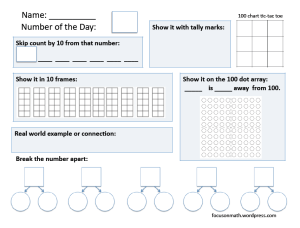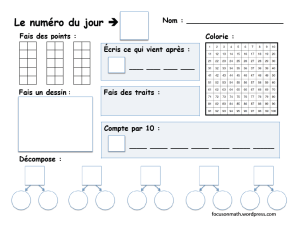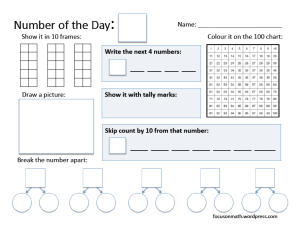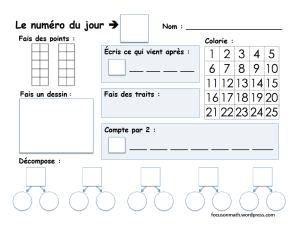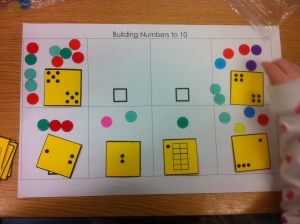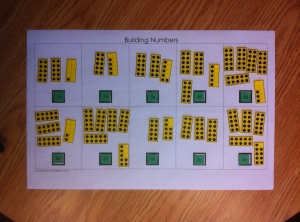I am inspired to begin a series of posts about math for younger children. For each topic we will discuss it on several levels, so wherever your child is on the math journey, hopefully there will be some ideas for you to engage with him or her.
It is important here to recognize that mathematics is reasoning and not memorization. While it is useful to commit to memory certain facts and procedures, it is essential that these facts and procedures develop with understanding. We want children to build networks of ideas that allow them to cope with novelty and solve problems they have not previously considered or encountered. Just memorizing facts and procedures can actually be debilitating, as it bypasses the important activity of building inter-connected mathematical ideas.
We begin this series with counting which is, indeed, the first foundation in math.
Counting involves at least two separate skills: saying the numbers in order and connecting this sequence in a one-to-one manner with the items being counted.
First, the child must learn the counting words in order, so say them over and over and over with the child. Make if fun, of course; a game, if you will, but it is in the repetition that the child will learn them (as is true for so much of her early learning).
Often we start with counting to 10, but don’t hesitate to count farther. (Of course this may vary with the age of your child. One may want to count a shorter sequence with a two year old than with a four year old.) In English there are no patterns at all in the first 12 numbers, and even in the teens the pattern is difficult for many children to recognize it. The obvious pattern of numbers does not really become apparent until we get to the twenties. Children must just memorize the counting sequence of numbers (yes, one of the places memorizing comes in handy!).
Saying the order is important but equally important is that the child is able to count one item for each number. Most of us have seen a child “counting” some items like blocks and randomly touching the blocks either more slowly or more quickly than actually saying the numbers. They seem to know touching is part of the process but have not understood the “one touch, one count” idea, otherwise known as one-to-one correspondence. How do they develop this? By doing it over and over. Experience and guidance play major roles in the development of counting skills, so counting often with your child benefits him greatly.
Matching the spoken counting words one by one to objects is generally easier if the objects are such that can be moved compared to those that cannot be moved. Movable objects allow the child to actually slide the object away from the ones yet to be counted. If objects to be counted are in a picture then a set that is ordered in some way is easier to count than a randomly displayed set. In the case of the latter a child often either misses items or tries to count them again.
There is one more important aspect here to consider, and that is that there must be meaning attached to the counting process. There is a difference between being able to count and knowing what the counting conveys. When we count a set of items, the last number word we say is used to represent the magnitude or the cardinality of the set.
When children understand that the last counting word said names the quantity of that set, they are said to have developed the cardinality principle. How can you tell if your child has developed the cardinality rule? Give them a set of objects and ask them, “How many are there?” If they emphasize the last number they likely have developed this. For example, they might say, “One, two, three, four, five. There are five.” I have asked children to tell me how many items there are and had them count the items, look at me, and when I repeat the question, “How many are there?” have them begin to count again. In that case the child seemed to interpret the question as a command to count rather than a request for the quantity in the set.
The only way to develop cardinality is by counting! Two activities are helpful here.
- Have the child count several sets of items that all have the same number of things but the items themselves are very different in size, e.g. six apples verses six grapes. Discuss how they are alike and how they are different.
- Have the child count a set of items, then rearrange the items and ask, “How many now?” If the child sees no need to count them again they likely have connected the cardinality to the set regardless of the arrangement of the items. If they want to count again, discuss why they think the answer is the same.
More on counting next time!
In the meantime, count often! Count everything!
Mathematically yours,
Carollee

 I am delighted to be here in Richmond, BC, today presenting at the BCTF’s New Teachers’ Conference. I am doing a similar workshop to what I did at the Calgary City Teachers’ Convention two weeks ago, but it is well worth the repeat in this city!
I am delighted to be here in Richmond, BC, today presenting at the BCTF’s New Teachers’ Conference. I am doing a similar workshop to what I did at the Calgary City Teachers’ Convention two weeks ago, but it is well worth the repeat in this city! The 100 Dot Array remains one of my favourite tools for helping students visualize numbers. This session at the CCTC focuses mainly on its use with students in grades 2 and 3, although it can be used at many other grade levels. We will be talking about the best way to introduce the tool to students, showing an early activity to help with general number sense, and using the number in problem solving situations. A variety of problem are included to show its diverse use.
The 100 Dot Array remains one of my favourite tools for helping students visualize numbers. This session at the CCTC focuses mainly on its use with students in grades 2 and 3, although it can be used at many other grade levels. We will be talking about the best way to introduce the tool to students, showing an early activity to help with general number sense, and using the number in problem solving situations. A variety of problem are included to show its diverse use.
